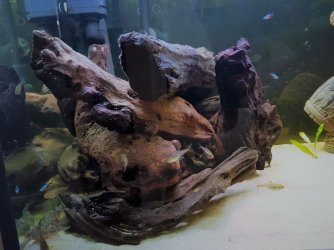Well that's very interesting. I have always followed the advice that its best to avoid anaerobic regions by regularly stirring the sand. Does anyone have links to on-line resources or more info. I'm not questioning the advice - but would like to understand better. Google has thrown up more articles / blogs suggesting that it should be avoided than encouraged.
I use playsand and the average depth is around 2", but I find flat surfaces boring so in the tank the depth ranges from around 1 - 4"
There are several things in this hobby that have been stated for decades, but which are no longer as accurate or correct as might have once been assumed. I will cut/paste from an article I wrote on bacteria some years ago, as this should answer the question.
The bacteria responsible for this nitrification process of converting ammonia to nitrite to nitrate are termed nitrifying. But the nitrogen cycle is only complete (in aquaria) when it includes de-nitrification; in this stage, different bacteria that are termed denitrifying convert nitrate into nitrogen gas which is released back into the atmosphere. There are also bacteria that use nitrate and produce oxygen. All of these live in the substrate. There are filters being marketed now that include (to some degree) this denitrification. [Another component of the complete nitrogen cycle in nature but not present in our aquaria involves the “fixing” of atmospheric nitrogen by cyanobacteria and other life forms.]
Denitrifying bacteria are heterotrophic bacteria, and there are several species; they utilize nitrate by consuming the oxygen within nitrate and releasing nitrogen gas. They do not require free oxygen in the water so they are facultative anaerobes, and generally occur in what we term “dead spots,” which occur when water movement is stopped and thus no oxygen is available. These are the good guys among heterotrophs, since de-nitrification is important in a healthy aquarium. And they will naturally occur in the lower level of the substrate, and under chunks of wood and rock. And as I said, there are filters being made now that encourage this stage as well as the first.
The waste control bacteria are species of heterotrophic bacteria that break down dead organic matter like fish waste, dead fish or plant matter, uneaten fish food, dead bacteria, etc. Some are aerobic, but many species are facultative anaerobes, able to live with or without oxygen. Like all bacteria, they colonize surfaces, and these are most prevalent in the substrate and the filter media. Many species can survive complete drying, allowing them to remain potent even when filter media that has been previously used is completely dry. These bacteria have only one requirement to appear and live: organics. They compete with autotrophic bacteria for both oxygen and surface area; studies show that even in relatively clean environments, they occupy more than 50% of the available surface area.
The greatest population of bacteria in a healthy balanced aquarium occurs in the substrate, not the filter. The floc or humic compost that collects in the substrate is the host for the biofilms; this is why the substrate in planted tanks should never be disturbed significantly, and many aquarists apply this to non-planted tanks as well.
In very general terms, aerobic nitrification takes place in the top 1-2 inches of the substrate; anaerobic de-nitrification takes place approximately 2-4 inches down, and anaerobic bacteria producing hydrogen sulfide occurs in substrates deeper than 3-4 inches. In all three cases, it will be deeper in coarse substrates (like pea gravel) and more shallow in finer substrates such as sand. These generalities will also vary with the presence of live plant roots and substrate “diggers” such as snails and worms, since these factors result in more oxygen being made available in the substrate, reducing anaerobic bacteria activity. An oxygen level in the substrate of as little as 1 ppm promotes nitrogen reduction rather than sulfur reduction (hydrogen sulfide).
Maintaining a substrate of fine gravel or sand no deeper than 4 inches, having live plants rooted in the substrate, and keeping Malaysian Livebearing snails are the best and safest methods of providing a healthy biological system for aerobic and denitrifying anaerobic bacteria. I have usually 2 inches overall of sand for my substrates, built up deeper in some areas and less (1/2 to 1 inch) in others. I don't have much anaerobic activity with these shallow depths, so I leave the areas under wood and rock alone to make up.




